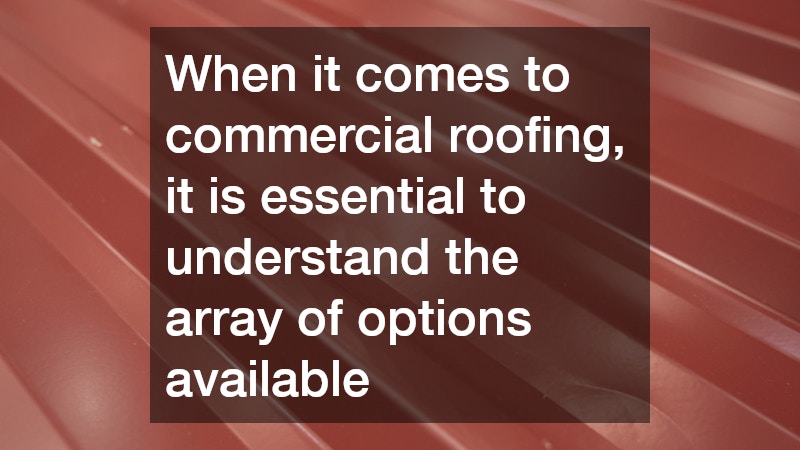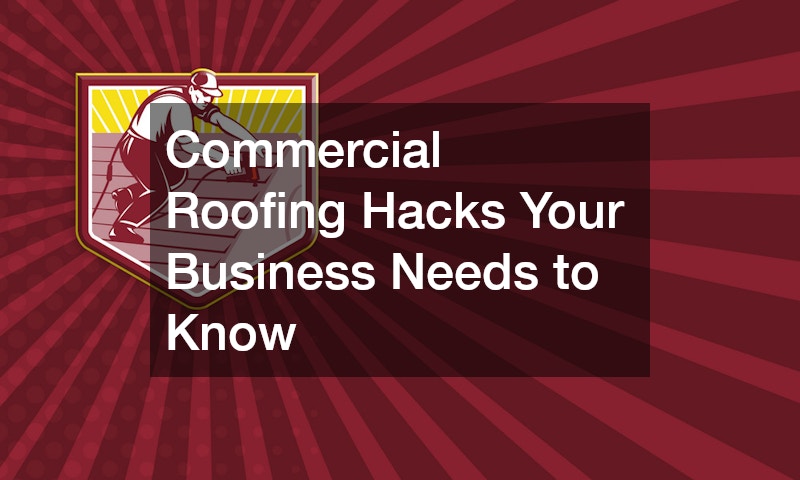When it comes to maintaining a business, commercial roofing might not be at the forefront of your mind until an issue arises. However, ensuring your roof is in optimal condition is crucial for the smooth running of any business. This knowledge can save you both time and money.
In this article, we’ll share some essential commercial roofing hacks that every business owner should be aware of.
Understanding Your Roofing Options
When it comes to commercial roofing, it is essential to understand the array of options available. Different materials offer varying benefits; therefore, selecting the right one is crucial for long-term sustainability. Common commercial roofing materials include TPO, EPDM, PVC, and metal. Each of these materials offers unique advantages, such as energy efficiency, durability, and cost-effectiveness.
For instance, TPO (thermoplastic olefin) is popular for its reflective properties which improve energy efficiency by reducing cooling costs. EPDM (ethylene propylene diene terpolymer), on the other hand, is known for its durability and ability to withstand various weather conditions. It’s crucial to evaluate the needs of your specific business operations, local climate, and budget when selecting a roofing system to avoid potential pitfalls.
Additionally, technology in roofing systems is continually advancing, providing even more options for businesses. Green roofing technologies and solar roofing systems, for example, can significantly reduce energy costs and leave a smaller carbon footprint. Therefore, aside from traditional options, exploring technological advances in commercial roofing might provide long-term cost-efficient solutions for your business.
Importance of Regular Inspections
Regular inspections are a crucial component of maintaining a healthy commercial roofing system. Ignoring this can lead to costly repairs, operational downtime, and even complete roof replacement. Regular inspections help identify minor issues before they escalate into major problems, saving your business money in the long run.
A routine inspection should cover every aspect of your roof, including checking for damaged shingles, leaks, pooling water, and deteriorating flashing. It’s advisable to perform these inspections bi-annually, ideally in spring and fall. Early detection through these checkups can extend the life of your roof significantly.
Hiring a professional roofing contractor to conduct these inspections ensures thorough evaluation and expert advice. In addition to saving money, regular maintenance and inspections can help boost your building’s energy efficiency, provide safety and assurance to tenants, and tip you off about necessary repairs in time.
Effective Roofing Maintenance Strategies
Implementing effective maintenance strategies is an essential aspect of commercial roofing management. Maintenance goes beyond simple inspections and involves active prevention of potential roofing issues. Cleaning debris, managing drainage systems, and ensuring the integrity of materials are part of a comprehensive maintenance strategy.
Prioritize clearing out gutters and drains to prevent water accumulation, which can lead to structural damage. Additionally, regular cleaning of the roof surface removes potential hazards such as moss, algae, and debris. Signing up for a maintenance contract with a roofing professional can mitigate abrupt damages by maintaining scheduled maintenance.
Erecting proper ventilation and insulation is another often-overlooked maintenance strategy that can increase the longevity of a roofing system. Adequate insulation helps maintain a stable internal environment, thus reducing pressure and wear on the roofing structure. Proper ventilation further ensures temperature regulation, minimizing the risk of thermal shock and extending the roof’s life.
Keeping Up with Industry Innovations
Keeping up with commercial roofing innovations can offer advantages that older systems fail to provide. Trends such as cool roofing and green roofs are becoming increasingly popular for their environmental benefits and cost savings. Moreover, new materials and designs are continually emerging, providing businesses with more choices suited to specific needs and climates.
Cool roofing materials are particularly appealing in areas with high temperatures, as they reflect more sunlight and absorb less heat. This can lead to significant reductions in energy costs. Furthermore, green roofs, while potentially more costly upfront, offer energy efficiency, natural insulation, and improved air quality over time.
Adapting these new technologies can potentially increase the property value and awareness of your business as a leader in sustainable practices. Therefore, staying informed about innovations in commercial roofing technology can provide both operational and marketing advantages. It reflects a proactive approach to maintenance and positions your business as forward-thinking and environmentally-conscious.
Cost-Saving Tips for Businesses
Investing in your commercial roof might seem costly; however, there are several strategies to save money without compromising quality. Comparing quotes from different contractors is a straightforward way to ensure competitive pricing. Yet, it’s vital to look beyond just the numbers and consider the contractor’s experience, reviews, and warranty policies.
A cost-effective approach also involves strategic planning, such as installing energy-efficient roofing systems or opting for preventative maintenance which avoids costly repairs. This initial investment can significantly reduce long-term operational costs. Additionally, exploring energy rebates or tax credits offered for installing energy-efficient roofs can provide considerable savings.
Another tip is to invest in high-quality materials that may cost more upfront but last longer and require fewer repairs. It prevents frequent replacements and guarantees longer service life, thereby reducing overall expenses. Cost-saving measures combined with the right maintenance strategy ensure a business gets the most value out of its roofing investment.


